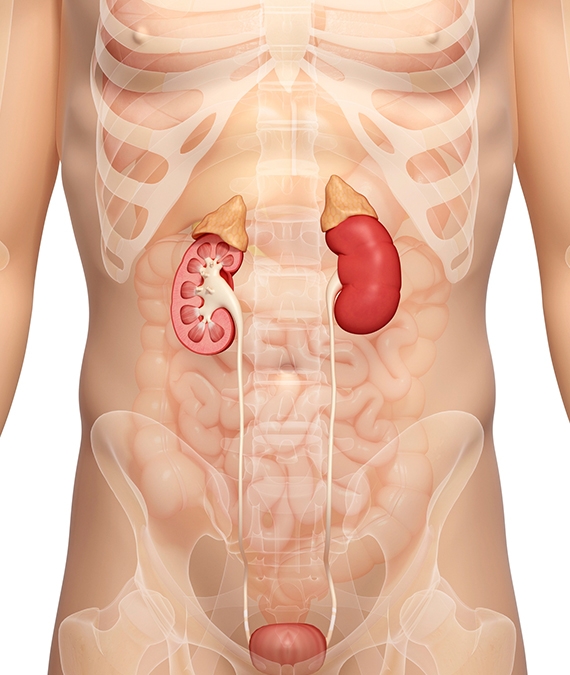Kidney diet cornerstones: Potassium
Kidney diet cornerstones: Potassium
Adapted from the original by Christine Nash, MSc(C), RD, CDE*
Antonia Zettas, RD, CDE*
What is it?
Potassium is one of the main minerals found in your blood. It is also an electrolyte, which means it carries an “electrical charge.” This charge helps your body carry out many important functions, including muscle contractions and maintaining a normal heart rate, both of which are necessary for a healthy heartbeat. It also plays a key role in metabolism, which converts the nutrients from our food into energy we need for our bodies.

Potassium and your kidneys
The kidneys play an important role in maintaining safe levels of potassium in the blood. When you are on dialysis, your kidneys are no longer able to balance potassium as efficiently. Many different factors can cause potassium levels to become too high or too low. This can be dangerous to your heart.
Potassium and your diet
Nutrition is central to managing your blood potassium levels when on dialysis. There are several things you can do with your diet to help keep your blood potassium at a safe level:
1) Food choices
Potassium can be found naturally in most foods, but some contain much higher amounts than others. For example, a ½ cup of sliced kiwi contains 3 times as much potassium as a ½ cup of diced pineapple.1
It is important to remember that everyone’s potassium needs are different. Foods you may be asked to limit or increase in your diet may not be the same as others. Your registered dietitian will work with you to develop an eating plan that is right for you.
2) Portion size
When it comes to potassium, serving size matters. Having a large amount of a low-potassium food can turn it into a high-potassium food. For example, one serving of 10 cherries is a low-potassium option. But if you have two servings (i.e. 20 cherries), the potassium content is the same as a small banana!1 On the other hand, higher potassium foods may fit into your diet if eaten in smaller amounts.
3) Reading labels
When choosing packaged foods, reading labels can help you determine how much potassium they contain. It is important to know that manufacturers are NOT required to report potassium in the Nutrition Facts Table.2 Just because the quantity is not included doesn’t mean the product is potassium-free! Some foods also contain potassium additives, which can contribute a large amount of potassium to your diet.3 Reading the ingredient list can help you identify what is in the product.
4) Food preparation
Potassium can be removed during the process of canning fruit and cooking vegetables.4,5 This may allow you to add more variety to your diet. For example, a ½ cup of canned papaya contains 2.5 times less potassium than a ½ cup of fresh papaya.1 Soaking and/or double boiling root vegetables can also remove extra potassium.5,6
Quick tip:
Watching your sugar intake? Be sure to drain the syrup or choose canned fruits that are packed in water.
Which method removes the most potassium from root vegetables?
- Soaking
- Soaking plus double boiling
- Double boiling
Answer: 3) Double boiling. It removes up to 70% of the potassium.7
How to double-boil potatoes:
- Peel and cut potatoes in small cubes, put them in a large pot, and cover them with cold water.
- Bring them to a boil. Remove the pot from the stove and drain the water.
- Add fresh water to cover the potatoes.
- Bring to a boil a second time, reduce heat, and simmer until potatoes are tender.
- Drain and discard the water.
Potassium and your dialysis treatment
Your dialysis treatment also plays a role in how much potassium you can include in your diet. If you are on a home dialysis therapy such as peritoneal dialysis (PD) you may not have the same potassium restrictions as someone who is receiving in-center hemodialysis (ICHD).
In PD, potassium is removed on a daily basis. Many patients also continue to have urine output, which provides additional removal of potassium from the body. Patients are often allowed more flexibility with the amount of potassium-rich foods they can include in their diet.
In ICHD, most patients receive dialysis multiple times a week. This means potassium can build up between dialysis sessions and as a result, patients are often required to limit their potassium intake. 8
How much potassium can I have?
The amount of potassium you can include in your diet will be different for everyone. Your dietary habits and type of dialysis treatment, along with other factors such as medications and urine output must be considered.8 Your registered dietician will work with you to determine your needs and develop a personalized nutrition care plan.
*Both authors are registered dietitians at the home peritoneal dialysis unit at the Toronto General Hospital (UHN). Christine Nash is the co-chair of the Canadian Association of Renal Dietitians (CAND).